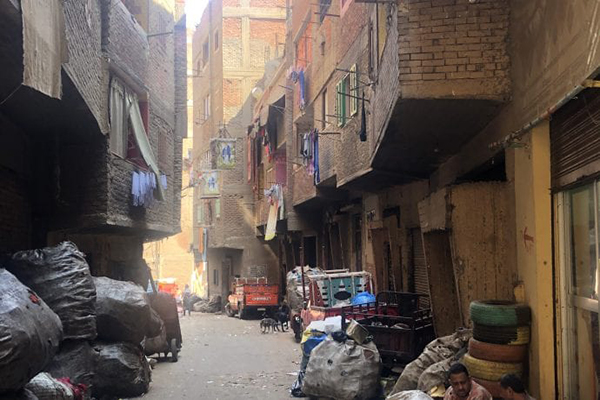
By Christopher White, The Tablet’s National Correspondent
CAIRO – Perhaps no place on earth serves as exhibit A for Pope Francis’s call to “resist the throwaway culture” better than Cairo’s Manshiyat Nasser neighborhood, where residents recycle an estimated 90 percent of the city’s trash.
For nearly 70 years the Zabbaleen of Manshiyat Nasser – or “Garbage City” as it’s more commonly known – have spent their days collecting the trash from the Egyptian capital and bringing it back to the neighborhood to recycle, feed the organic waste to local pigs, and sort out the rest to dispose of or sell off.
Yet while garbage collection may be the day job of the residents, the overwhelming majority of the neighborhood’s nearly 60,000 denizens are Coptic Orthodox Christians who have centered their life around the Monastery of Saint Simon, which sits atop the district.

Built into a natural cave along a cliff, the dramatic 20,000 seat outdoor stone church – the largest of four on the monastery grounds – has become an off the beaten path tourist attraction and a second home for local Copts as well as those from outside of Cairo who make pilgrimage to the site.
Piles of garbage fill the winding streets below, but the apartment buildings, cafes, and markets are dotted with religious icons, demonstrating that while the area may be known for its trash, its residents are defining themselves by their Coptic faith.
When asked about their routines and daily lives, long-time residents are quick to pivot to the monastery as being at the center of it all.
Sallah, a fifty-year resident of Garbage City told The Tablet that he wakes up at six in the morning and works a twelve-hour day collecting and sorting trash.
“This is a blessed place where we live though,” he insists, while sitting on a blue bucket with flies swarming all around him. “It’s special for us.”
Simon, who is named after the very saint whose church is the patron of the neighborhood, also echoed those words, noting that he and his four other siblings couldn’t think of living anywhere else.
While his parents work in the garbage industry, Simon, who is twenty-five years old, works at the monastery, organizing programs for the neighborhood children.
“A miracle happened in this neighborhood,” he told The Tablet. “Living here reminds us of that and teaches us tolerance and love.”
That miracle he described is the tenth century story of Simon the tanner.
According to tradition, the then Coptic Patriarch Abraham was challenged by the Muslim caliph that if the words from scripture that when one has the faith of a mustard seed, he can move mountains were true, then he must prove it – and if he failed, all of the Copts would be slaughtered.
Simon, according to the story, advised Abraham, that he must cry out “O Lord, have mercy” three times and make the sign of the cross over the mountain, and when he did, the mountain was miraculously moved.
More than ten centuries later, the extraordinary and seemingly impossible story of Simon is sustaining the ordinary, though grueling, lives of those who live around the church built in his honor.
Father Boutros, one of the Coptic priests at the monastery, spends his days visiting the residents of the neighborhood, hearing their confessions, and baptizing their children – as well as those who want to convert, putting him at some risk, in the Muslim majority country.
“My service for God is to tell people about Christ and bring people to Christ, whatever the price,” he said during a briefing last week to a group of Catholic journalists and educators, including The Tablet, sponsored by the Philos Project, an organization dedicated to “promoting positive Christian engagement in the Middle East.”
Yet precisely because of his daring actions, in many ways he’s come to singularly symbolize the resilient, fervent faith of the often-marginalized Coptic Christians of Garbage City who consider it a privilege to live in such a place.
After Cairo officials made the decision in the 1960s to relegate the city’s garbage collectors to what was then an area outside of the city, the already poor residents pooled their limited resources and their remaining few free hours to work tirelessly on building themselves a church. After moving some 2.5 million tons of rock, they completed the cave church in 1975.
Today, the monastery is both a place of daily worship, but also a permanent reminder set in stone that the Copts, though persecuted for thousands of years, are staying put.
Writing in his landmark 2015 letter on the environment, Laudato si’, Pope Francis condemned the “throwaway culture” as an attitude where the poor, the elderly, and those on the peripheries of society are treated like waste, which “quickly reduces things to rubbish.”
“The earth, our home, is beginning to look more and more like an immense pile of filth,” he wrote, demanding that both individual and institutions undergo a conversion.
For those seeking to heed the Holy Father’s advice, ironically enough, Cairo’s Garbage City, might serve as an ideal place to start.
